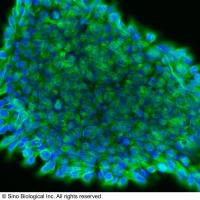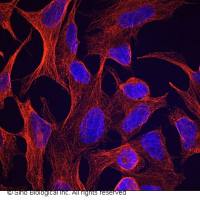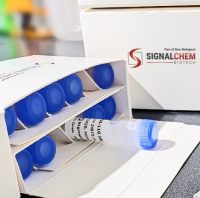Tubulin Preparat
互联网
1118
Materials
| 3 - 5 Fresh Pig Brains |
|
1 M GTP |
| 1 M Magnesium Sulfate |
| PM buffer = |
100 mM Pipes, pH 6.9 2 mM EGTA 1 mM Magnesium Sulfate 2 mM DTT |
| PM-4M Buffer = |
100 mM Pipes, pH 6.9 2 mM EGTA 1 mM Magnesium Sulfate 2 mM DTT 4 M Glycerol |
| PM-8M Buffer = |
100 mM Pipes, pH 6.9 2 mM EGTA 1 mM Magnesium Sulfate 2 mM DTT 8 M Glycerol 0.1 mM GTP |
| PC Column (20 mL phosphocellulose resin in 2.5 cm diameter column) equilibrated in PM buffer |
Special Equipment
| Waring Blender |
| Dounce homogenizer (15 mL) |
Procedure
| 1. | Obtain pig brains and measure the weight. Keep on ice. |
| 2. | Working rapidly, remove meninges and blood vessels with Kimwipes at 4°C. Prepare enough space in cold room for 2-3 persons working together at this step. (Need bench cover, trash bag, Waring blender, 300 ml beaker in ice bucket.) |
| 3. | Mince the tissues rapidly with scissors that have been rinsed with ethanol, then add PM-4M buffer at a ratio of 100 ml per 100 g of tissue (save a third to rinse the blender jar), and homogenize the tissue in a precooled Waring blender at the lowest speed for 40 sec. Transfer the mixture into a new beaker and rinse out the blender jar with small volume of the PM-4M buffer. |
| 4. | Centrifuge the homogenate for 15 min at 4°C at 9 500 rpm in the Sorvall SS-34 rotor (6 500 g). |
| 5. | Decant the supernatants into 30 ml Beckman ultracentrifuge tubes on ice and centrifuge at 30 000 rpm in a Beckman Ti70 rotor (96 000 g) for 75 min at 4°C. |
| 6. | Decant the supernatants into a graduated cylinder and check the volume (V1). |
| 7. | Add 1 M GTP to a final concentration of 0.5 mM and mix gently by inverting the cylinder serveral times. Transfer into new 30 ml ultracentrifuge tubes. |
| 8. | Balance the tubes and incubate for 45 min in a water bath at 34°C (the solution at this stage is pinkish). During the incubation, warm the Ti70 rotor with tap water and set the ultracentrifuge temperature to 27°C. |
| 9. | Centrifuge the tubes for 60 min at 27°C at 30,000 rpm to pellet the assembled microtubules. |
| 10. | At room temperature, decant the supernatants from the firm and slightly opalescent pellets. |
| 11. | Resuspend the pellets in a volume of 0.25 x V1 of ice-cold PM buffer. |
| 12. | Remove the pellets from the bottoms of the tube by gently scraping with a glass rod. Pour the resulting suspension into an ice-cold Dounce homogenizer and homogenize using 5 gentle strokes of the pestle to produce a uniform suspension. |
| 13. | Incubate the suspension on ice for 30 min to depolymerize microtubules. |
| 14. | Transfer into ice-cold ultracentrifuge tubes and centrifuge at 30 000 rpm at 4°C for 60 min in a Beckman Ti70 rotor. |
| 15. | Carefully remove the supernatants from the pellets, which are sometimes loose, and pool in a graduated cylinder. Note the volume (V2). |
| 16. | Add an equal volume of PM-8M, mix gently and store at -20°C. The tubulin at this stage can be stored as long as 72 hrs. |
| 17. | A second cycle of polymerization/centrifugation and depolymerization/ centrifugation is carried out by first incubating the mixture at 34°C as described above (steps 8-10). Resuspend the resulting pellets in 0.25 x V2 of cold PM buffer, incubate at on ice for 30 min and centrifuge again (steps 11-15). |
| 18. | The resulting cold supernatant is ~90% pure tubulin and is called twice-cycled tubulin. Further purification is by phosphocellulose column chromatography. |
| 19. | Prepare a PC column (20 mL PC resin in 2.5 cm diameter column) and equilibrate the column in PM buffer. |
| 20. | Prior to collection, 1 M Magnesium Sulfate is added to the collection tubes to make a final concentration of 1 mM. |
| 21. | Apply the twice-cycled tubulin to the PC column and elude the column with PM buffer at a flow rate of 15 mL per hour collecting 0.5 - 1 mL fractions. The first eluate is purified tubulin protein. Do not mix with later peak fractions, which contain microtubule-associated proteins (MAPs). Pool the purified tubulin +/- MAPs, divide into 0.5 mL aliquots, freeze in liquid nitrogen and store at -80°C. |
Next day
Notes
| 1. | Tubulin is labile and yields will be greatly improved by working rapidly in the initial steps of the preparation. |









